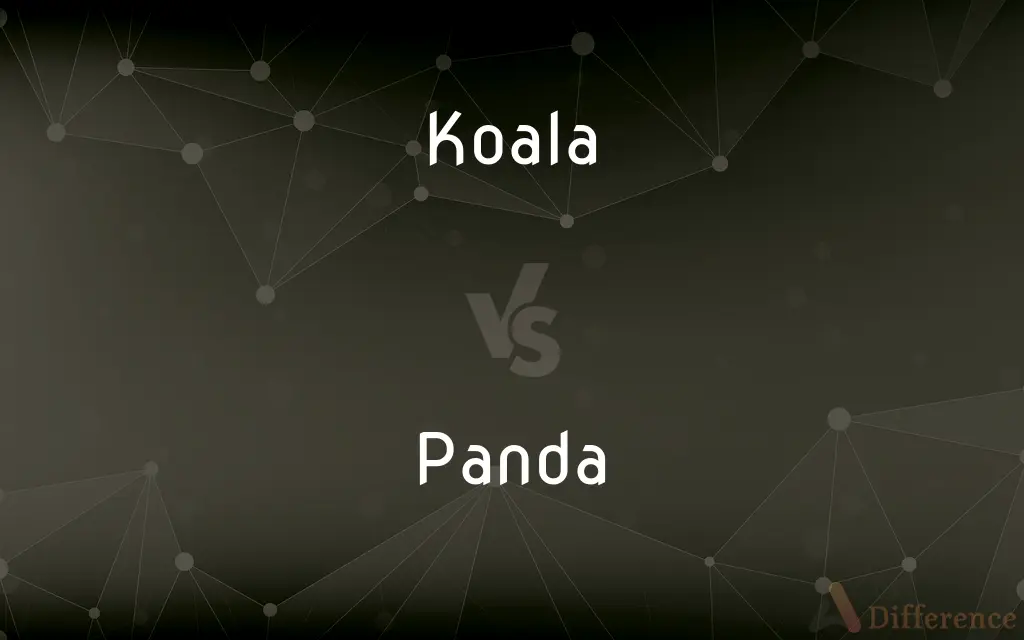Koala vs. Panda — What's the Difference?
Edited by Tayyaba Rehman — By Urooj Arif — Updated on March 8, 2024
Koalas are marsupials native to Australia, primarily eating eucalyptus leaves, while pandas are bears from China, known for their bamboo diet.

Difference Between Koala and Panda
Table of Contents
ADVERTISEMENT
Key Differences
Koalas, found exclusively in Australia, are marsupials, meaning they carry their young in a pouch. On the other hand, pandas, specifically the giant panda, are a bear species found in the mountain ranges of central China and do not have a pouch for rearing their young.
The diet of a koala consists almost entirely of eucalyptus leaves, which are toxic to most animals. This specialized diet allows them to live in the eucalyptus forests of eastern and southern Australia. Conversely, pandas primarily eat bamboo, which makes up more than 99% of their diet, requiring them to consume a large quantity each day to meet their energy needs due to bamboo's low nutritional value.
Koalas are smaller and lighter than pandas, with young typically weighing between 4 to 15 kilograms. In contrast, an young panda weighs between 100 to 150 kilograms, showcasing a significant size difference between the two species.
Reproductive strategies also differ; koalas give birth to underdeveloped young that crawl into their mothers' pouches to continue developing. Pandas give birth to relatively helpless young as well, but they nurture their offspring in a den rather than a pouch.
Conservation status highlights another difference; koalas are classified as "Vulnerable" due to habitat destruction and climate change, while the giant panda's status was upgraded from "Endangered" to "Vulnerable" thanks to concerted conservation efforts in China.
ADVERTISEMENT
Comparison Chart
Classification
Marsupial
Bear
Habitat
Australia
Central China
Diet
Eucalyptus leaves
Bamboo
Reproduction
Birth to underdeveloped young that mature in a pouch
Birth to helpless young raised in a den
Conservation Status
Vulnerable
Vulnerable (Improved from Endangered)
Compare with Definitions
Koala
An arboreal marsupial native to Australia.
The koala clung to the eucalyptus tree, munching on leaves.
Panda
A large bear-like mammal from China.
The panda lazily ate bamboo in the forest clearing.
Koala
Carries young in a pouch.
After birth, the koala joey crawls into its mother's pouch to continue developing.
Panda
Bamboo as a primary diet.
Pandas spend up to 12 hours a day eating bamboo to meet their energy needs.
Koala
Eucalyptus leaf eater.
Koalas have a highly specialized diet, feeding almost exclusively on eucalyptus leaves.
Panda
Requires a large territory.
Pandas require large territories of bamboo forests to sustain their diet.
Koala
Solitary and territorial.
Koalas are solitary animals, with each having its own territory within the forest.
Panda
Black and white fur.
The panda's distinctive black and white fur helps it blend into the snowy and rocky backgrounds.
Koala
Vulnerable species.
Koalas are considered vulnerable due to their declining habitat.
Panda
Conservation success story.
Through intensive conservation efforts, the panda has moved from endangered to vulnerable.
Koala
The koala or, inaccurately, koala bear (Phascolarctos cinereus), is an arboreal herbivorous marsupial native to Australia. It is the only extant representative of the family Phascolarctidae and its closest living relatives are the wombats, which are members of the family Vombatidae.
Panda
A bear (Ailuropoda melanoleuca) of the mountains of central China, having woolly fur with distinctive black and white markings. Also called giant panda, panda bear.
Koala
An arboreal Australian marsupial (Phascolarctos cinereus) that has dense grayish fur, large ears, and sharp claws and feeds chiefly on the leaves of eucalyptus trees.
Panda
An arboreal raccoonlike mammal (Ailurus fulgens) of northeast Asia, having reddish fur, white face markings, and a long ringed tail. Also called lesser panda, red panda.
Koala
A tree-dwelling marsupial, Phascolarctos cinereus, that resembles a small bear with a broad head, large ears and sharp claws, mainly found in eastern Australia.
Panda
The red panda (Ailurus fulgens), a small raccoon-like animal of northeast Asia with reddish fur and a long, ringed tail.
Koala
A tailless furry marsupial (Phascolarctos cinereus), found in Australia. The female carries her young on the back of her neck. Called also Australian bear, koala bear, native bear, and native sloth. The koala lives almost all of its life in trees, moves sluggishly like a sloth, and eats eucalyptus leaves almost exclusively.
Panda
(Hinduism) A brahmin who acts as the hereditary superintendent of a particular ghat or temple, and is regarded as knowledgeable in matters of genealogy and ritual.
Koala
Sluggish tailless Australian arboreal marsupial with gray furry ears and coat; feeds on eucalyptus leaves and bark
Panda
A small Asiatic mammal (Ailurus fulgens) having fine soft fur, which inhabits the mountains of Northern India. It was once thought to be related to the bears, but is now believed to be more closely related to raccoons. It has reddish-brown fur on the back and sides, and black fur on the legs and underside. Called also the lesser panda.
Panda
The giant panda (Ailuropoda melanoleuca), a bearlike black-and white mammal now found wild only in the central forests of China, which lives mainly on on bamboo. It is an endangered species, and is a popular attraction in the few zoos which have bveen able to obtain specimens.
Panda
Large black-and-white herbivorous mammal of bamboo forests of China and Tibet; in some classifications considered a member of the bear family or of a separate family Ailuropodidae
Panda
Reddish-brown Old World raccoon-like carnivore; in some classifications considered unrelated to the giant pandas
Common Curiosities
Are koalas considered bears?
No, despite their bear-like appearance, koalas are marsupials, not bears.
Why do koalas eat eucalyptus leaves?
Koalas have specialized digestive systems that detoxify the poisonous compounds in eucalyptus leaves, which other animals cannot digest.
Can pandas live outside of China in the wild?
Pandas are adapted to the bamboo forests of central China and do not naturally occur in the wild outside of this region.
Why do koalas only live in Australia?
Koalas are native to Australia and have evolved to thrive in its specific eucalyptus forest habitats.
How much bamboo do pandas eat each day?
Pandas can eat 12 to 38 kilograms of bamboo each day, depending on the bamboo species and the panda's size.
Why are pandas black and white?
The panda's black and white coloring may serve as camouflage in their natural habitat and for communicating their social and aggressive intentions.
What are the main threats to pandas and koalas?
Both species face habitat loss and fragmentation, though koalas are also threatened by disease and climate change.
Can koalas and pandas be pets?
Neither koalas nor pandas are suitable as pets due to their specialized diets, habitat needs, and conservation status.
How long do koalas live?
Koalas typically live around 10 to 12 years in the wild.
Are there different types of pandas?
Yes, besides the well-known giant panda, there is also the red panda, which is smaller and has a different diet and habitat.
Do koalas have any natural predators?
Koalas' natural predators include large birds of prey, dingoes, and in some areas, domestic dogs and cats.
How do pandas communicate?
Pandas communicate through vocalizations, scent marking, and body language.
What is the reproductive rate of koalas and pandas?
Both have low reproductive rates, which challenges their populations' growth and recovery.
How has climate change affected koalas and pandas?
Climate change threatens koalas by impacting their eucalyptus habitat and pandas by affecting the bamboo availability.
How are koalas and pandas being protected?
Conservation efforts include habitat preservation, breeding programs, and in the case of pandas, successful reforestation and protection measures in China.
Share Your Discovery

Previous Comparison
Healthy vs. Healthful
Next Comparison
Respiration vs. FermentationAuthor Spotlight
Written by
Urooj ArifUrooj is a skilled content writer at Ask Difference, known for her exceptional ability to simplify complex topics into engaging and informative content. With a passion for research and a flair for clear, concise writing, she consistently delivers articles that resonate with our diverse audience.
Edited by
Tayyaba RehmanTayyaba Rehman is a distinguished writer, currently serving as a primary contributor to askdifference.com. As a researcher in semantics and etymology, Tayyaba's passion for the complexity of languages and their distinctions has found a perfect home on the platform. Tayyaba delves into the intricacies of language, distinguishing between commonly confused words and phrases, thereby providing clarity for readers worldwide.














































